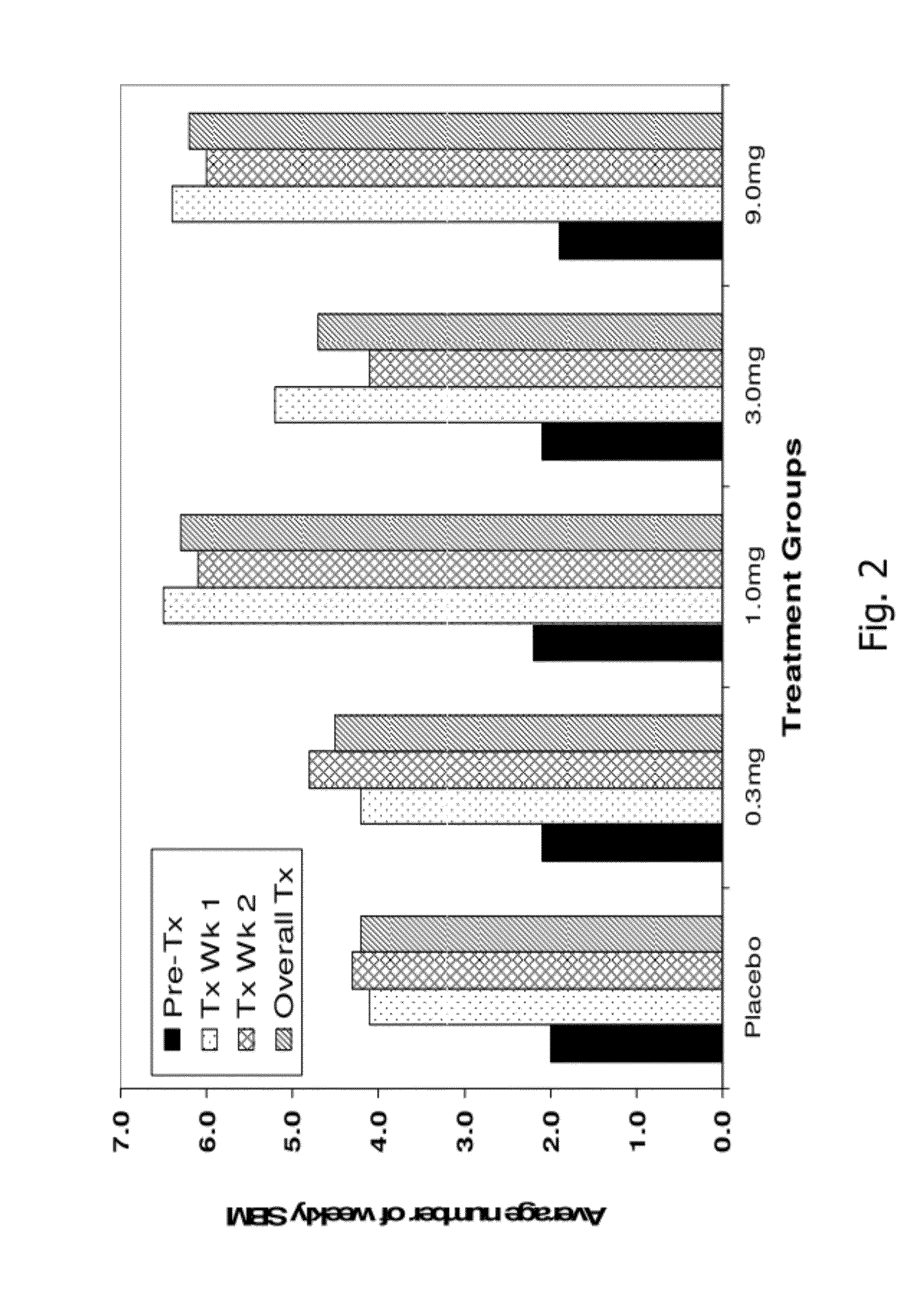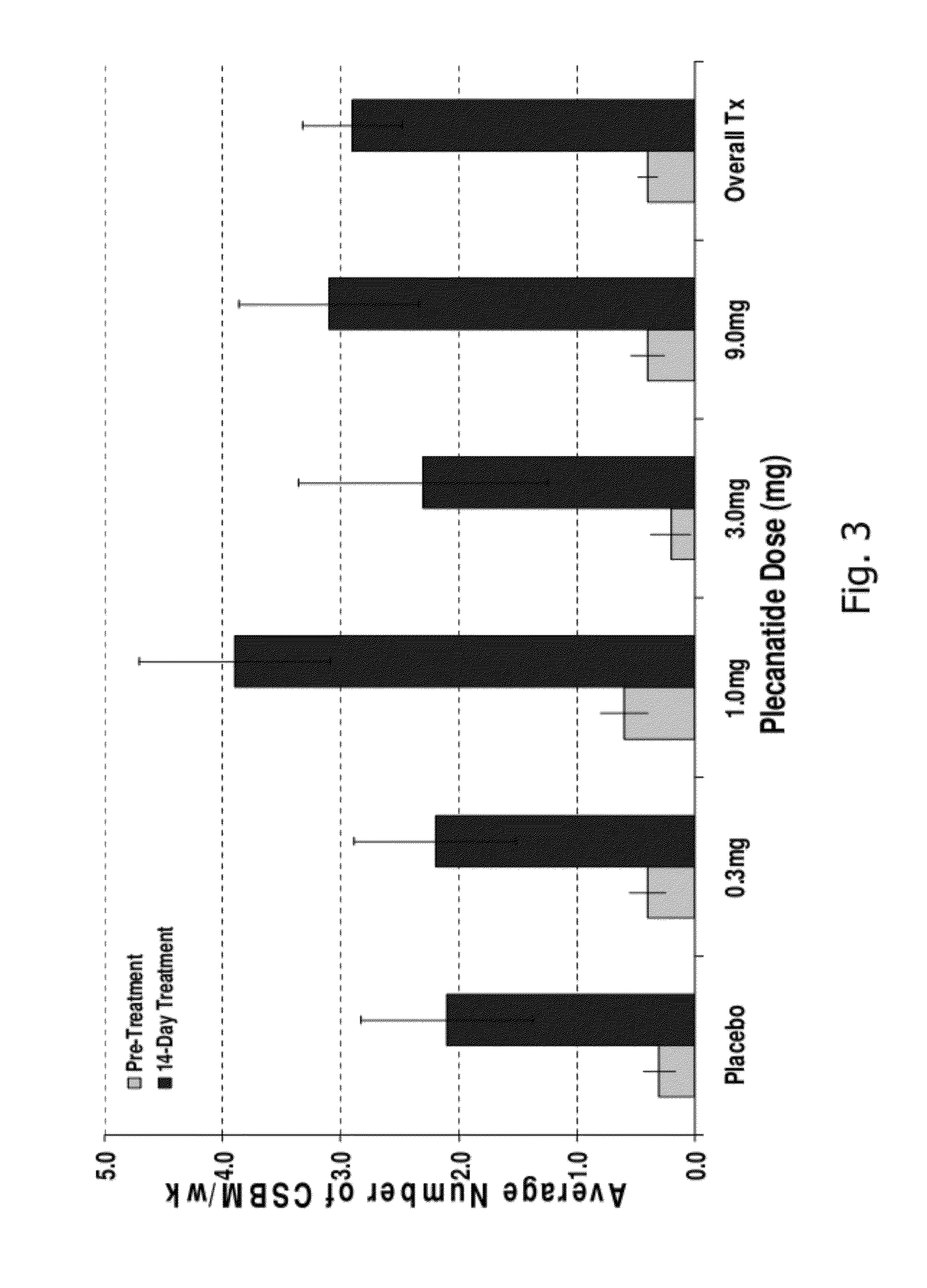Formulations of Guanylate Cyclase C Agonists and Methods of Use
a technology of guanylate cyclase and formulation, which is applied in the field of low-dose formulations of guanylate cyclase c peptide agonists, can solve the problems of chemical and physical instability of the formulation, the risk factor of irritable bowel syndrome, and the susceptibility to inflammatory stimuli, and achieve the effects of unexpected effect, treatment or prevention of chronic idiopathic constipation, and superior properties
- Summary
- Abstract
- Description
- Claims
- Application Information
AI Technical Summary
Benefits of technology
Problems solved by technology
Method used
Image
Examples
example 1
Clinical Study for Safety and Efficacy in Humans for the Treatment of Chronic Idiopathic Constipation
[0191]A randomized, double-blind, placebo-controlled, 14-day repeat oral, dose ranging study was conducted in patients with chronic idiopathic constipation (CIC). The primary objective of this study was to evaluate the safety of SP-304 (1.0 mg, 3.0 mg, 9.0 mg and 0.3 mg) for 14 days in patients with CIC. One secondary objective was to assess the pharmacokinetic profile of SP-304 in plasma. Other secondary objectives included evaluations of pharmacodynamic effects (efficacy) on parameters such as the time to first bowel movement after daily dosing with SP-304, bowel habits over time—for example, spontaneous bowel movements (SBMs), complete spontaneous bowel movements (CSBMs), and stool consistency [using Bristol Stool Form Scale (BSFS)]—and other patient reported outcomes such as abdominal discomfort.
[0192]The study included five arms with assigned interventions as indicated in the ta...
example 2
Composition of Wet Granulation batch 10005
[0199]
Item No.IngredientUseConcentration % w / w1SP3040.232Mannogem EZ,Diluent79.77USP / EP (Mannitol)3PROSOLV SMCC 90Binder15.0LM (silicifiedmicrocrystallinecellulose)4Purified Watervehiclen / a(chilled to 5° C.), USP5Purified Watern / a(chilled to 5° C.), USP6Explotab (SodiumDisintregant4.0Starch Glycolate)7Pruv (sodium stearylLubricant1.0fumarate)Total100
example 3
Composition of Wet Granulation batch 10007
[0200]
Item No.IngredientUseConcentration % w / w1SP3040.33PROSOLV SMCC 90Binder95.7HD (silicifiedmicrocrystallinecellulose)4Purified Watervehiclen / a(chilled to 5° C.), USP5Purified Watern / a(chilled to 5° C.), USP6Explotab (SodiumDisintregant4.0Starch Glycolate)Total100
PUM
| Property | Measurement | Unit |
|---|---|---|
| chromatographic purity | aaaaa | aaaaa |
| chromatographic purity | aaaaa | aaaaa |
| chromatographic purity | aaaaa | aaaaa |
Abstract
Description
Claims
Application Information
 Login to View More
Login to View More - R&D
- Intellectual Property
- Life Sciences
- Materials
- Tech Scout
- Unparalleled Data Quality
- Higher Quality Content
- 60% Fewer Hallucinations
Browse by: Latest US Patents, China's latest patents, Technical Efficacy Thesaurus, Application Domain, Technology Topic, Popular Technical Reports.
© 2025 PatSnap. All rights reserved.Legal|Privacy policy|Modern Slavery Act Transparency Statement|Sitemap|About US| Contact US: help@patsnap.com



